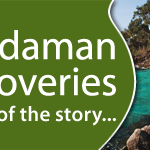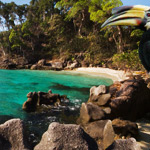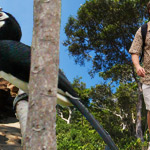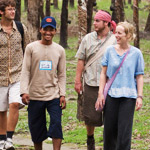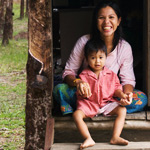Andaman Discoveries Blog
Thursday, December 29, 2011
Learning from the Moken
“Where are you from?, we asked the guides from the village. “From the Moken” they said.
Patiently we asked again: “Alright you are Moken, but… where are you from?” Their answer remained the same: “From the Moken”.
After a bumpy hour and a half ride on a speedboat and another short ride on a long-tail we have had finally arrived at the Moken Village on Surin Island off the North Andaman coast of Thailand.
AD founder Bodhi Garret was leading the pilot tour organized for our guests (writer Oliver and photographer Catherine) from the BBC’s Lonely Planet Magazine.
Bodhi has known the Moken people for some
 time now and the respect he has for them is mutual and evident from the way they greeted each other with friendly smiles and warm hugs. After all not many ‘farang’ speak Thai with ease like Bodhi does and are able to communicate directly with the indigenous peoples from this region. We all felt very privileged to be part of the pilot tour, which was meant to establish AD’s ‘Life of the Moken’ program as a responsible and ethical alternative to the tours, which others operate on the island.
time now and the respect he has for them is mutual and evident from the way they greeted each other with friendly smiles and warm hugs. After all not many ‘farang’ speak Thai with ease like Bodhi does and are able to communicate directly with the indigenous peoples from this region. We all felt very privileged to be part of the pilot tour, which was meant to establish AD’s ‘Life of the Moken’ program as a responsible and ethical alternative to the tours, which others operate on the island.The Moken have provoked interest ever since the tsunami struck this region and
 these nomadic sea gipsy people had to make a more permanent settlement on the island.
these nomadic sea gipsy people had to make a more permanent settlement on the island.It is no wonder that for us the question ‘where you from?’ seemed like a logical one, but the answer we received showed just how our perception of ones origin was only limited to indicate a place. For the Moken guides who were showing us around their village and gave us a glimpse of their world, this same question carries the meaning of the people you grew up with, the values that you learned, rather than a physical location.
Traditionally, the Moken sea nomads traveled to coastal and island areas in the Mergui Archipelago by their “kabang” (boat), which served both as a home and means of transportation. They would spend seven months fishing during the dry season and take refuge on land during the monsoon. As an ethnic minority in Thailand they are struggling to keep their legacy alive.
The Moken guides led us through their village, shared stories of their lives and gave insights into their struggles and dreams. On the “Chok Madah” Nature-Culture Trail through the jungle behind the village, they showed us various types of plants and trees that they use in daily life; edible herbs, healing plants and woods used for the construction of their huts and boats. In Moken language, Chok means a small bay, and Madah is the name of a local man who anchored his boat in the bay to gather shellfish and forest products. The Moken who now live a semi-nomadic life have used this foraging trail for generations. Twenty stations with interpretive signs are placed along the trail, providing information on specific topics and insights into the world of the Moken.

On a our second day accompanied by our Moken guides we set off on a long tail boat for a snorkeling dive, at a site known as Nemo bay, frequented by the beautiful clown fish of that name. To observe our Moken guides while snorkeling is an experience in itself, for you would never see someone show such grace and peacefulness while diving down to point at the hiding moray eel. Back on the boat Pi Tao, an elder Moken with a peaceful smile, had just finished brewing delicious coffee for all to enjoy.
A couple of days in the company of these kind hearted and warm people inevitably makes you appreciate their culture and wonder about their future. With no written language, their children are taught to speak, read, and write in Thai. This raises a challenge for passing on the traditional Moken language and knowledge to future generations.

The AD tour is specifically designed to take into consideration the Moken’s wishes, encouraging respectful and meaningful encounters between tourists and Moken people.
We spent the night in bungalows on one of the smaller northern islands. The landscape was hauntingly beautiful, the setting sun providing a spectacular background to the mangroves on the beach.
Upcoming tours will allow guests to take home not only picture souvenirs but also lasting memories. We hope to foster a new understanding between the Sea dwellers and us as we have a lot to learn from them.

You can participate in various activities in which your Moken guide will show you how to spear hunt, row a traditional Moken boat, weave small items out of pandanus leaf, and learn about their magical underwater world. You will also learn about their mythology and beliefs; as animists the Moken worship and believe in the spirits of nature.
Our adventure came to end but we know that we will return one day and hope to share this beautiful encounter with other likeminded people who want to experience the Moken culture and make a much needed contribution that will directly benefit the people you visit.
Labels: community-based tourism, education, Moken, responsible tourism
Saturday, December 24, 2011
Meals for Needy Kids
Lunch for the Burmese Learning Center
 The Kuraburi area, and southern Thailand in general, is home to a large population of Burmese migrant workers. These hardworking people often come illegally in the hope of finding income and a better life.
The Kuraburi area, and southern Thailand in general, is home to a large population of Burmese migrant workers. These hardworking people often come illegally in the hope of finding income and a better life.
Their children mostly lack access to education and adequate nutrition. Unlike so many other areas, Burmese children living near the Kuraburi pier are able to take classes at a learning center. The dedicated teachers at the center have requested our help in providing lunch for the children. Without a food budget, and barely able to cover teacher salary, the center needs our help to make sure the kids have a healthy lunch.
SOLUTION:
It costs less than $1 USD per day to make a difference.
Financial support is needed for cooking equipment plus ingredients for 90 meals a day, 5 days a week, for the nine month school year. The teachers would prepare the food and would receive semi-annual cooking stipends of 1,000 baht per month, shared between the cooks.
The lunch program will:
+ guarantee that children have one healthy nutritious meal a day
+ create community by bringing together teachers and volunteers to cook and then share a meal with the children
+ give the children an opportunity to learn roles and responsibilities during cooking, eating, and cleanup
+ alleviate the financial burden on already struggling parents
PLEASE HELP - YOU CAN MAKE A DIFFERENCE IN THE
QUALITY OF LIFE AND GENERAL HEALTH OF THE CHILDREN
In total, we are aiming to raise at least 9 months (one school year) worth of lunch money. The cost of
feeding the children for a month is $1,250 (960 Euro), meaning we hope to raise a total of $11,000 (8,500 Euro).
Please contribute whatever you can, and together, we can do it!
Labels: community development, Southern Thailand Volunteering
Wednesday, December 14, 2011
Saving the World – Year 3
100 kids, 15 villages, 1 purpose
For the third year in a row, we brought together 16 youth groups from the Andaman coast – all from different villages, and all working on local environmental and social issues. The seminar took place at Hat Praphat Research station, where the youth shared their experiences in protecting the environment. They then headed into the field to see local examples of conservation in action.
The following story is from the field trip 'Water Lily Rafting":
After a nutritious breakfast the group left the lodging and then after a 20-Minute ride we arrived at our destination, the meeting room of the Nakha Community Conservation Group.The group met with a park ranger in a small hut and was given an introduction on the national park, its river‚ Nakha’ and the existing flora and fauna. In his speech he constantly included the human element, our functions and behaviors within this particular ecosystem and global system and the impact we have on nature.
 For example, if a local resident needs some wood to build his lodge, he is allowed to cut a tree, but for cutting one he has to replace five new ones. And commercial use is strictly prohibited, this encourages people to think and be responsible. After a question and answer session everybody was looking forward to the activity: bamboo-rafting. Each bamboo raft held 3-6 people plus two ferrymen who navigated the canoe with a long bamboo stick.
For example, if a local resident needs some wood to build his lodge, he is allowed to cut a tree, but for cutting one he has to replace five new ones. And commercial use is strictly prohibited, this encourages people to think and be responsible. After a question and answer session everybody was looking forward to the activity: bamboo-rafting. Each bamboo raft held 3-6 people plus two ferrymen who navigated the canoe with a long bamboo stick.
The river was in some parts very fast and made it difficult for the ferrymen to navigate the boat properly. Rapids turned the boats upside down and the crew had a chance to take a spontaneous swim. While the group floated down the river everybody observed the breathtaking nature with all its beauty. But when the group arrived at the water-lily conservation area it was very alarming.
 Some years ago the whole area was abundant with water lilies. However due to dredging the river, many plants, seeds and roots were washed away and the tragic news is they will probably never come back. There were just a couple of blossoms to look at. Through this trip we are trying to educate and spread the word that river dredging changes the conditions for a lot of nature in the area, water lilies included, we have to think about what we are doing and the effects that it will cause.
Some years ago the whole area was abundant with water lilies. However due to dredging the river, many plants, seeds and roots were washed away and the tragic news is they will probably never come back. There were just a couple of blossoms to look at. Through this trip we are trying to educate and spread the word that river dredging changes the conditions for a lot of nature in the area, water lilies included, we have to think about what we are doing and the effects that it will cause.
Read more about Water Lilies here.
Tuesday, December 13, 2011
From the Phratong Island: New Colors in Ban Lion

Working at the Community Conservation Center
 The rainbow over Ban Lion was not the only source contributing to varying colors on the Phra Thong Island. In the time span of two weeks, many different hands engaged in the construction and
The rainbow over Ban Lion was not the only source contributing to varying colors on the Phra Thong Island. In the time span of two weeks, many different hands engaged in the construction and  renovation of the Community Conservation Centre (CCC). New plants decorate the garden and are expected
renovation of the Community Conservation Centre (CCC). New plants decorate the garden and are expected  to grow as a natural protection from wind and sun. The community area offers new seating accommodation, while stairs, windows and walls appear in fresh and vibrant colors.The colors are not only a joy for the eye but will keep termites at bay. At the time of the construction, the CCC had already served its purpose of facilitating meetings and gatherings, for larger and smaller occasions. Villagers and children came together with volunteers to work on the centre and home stay families greeted their guests in the community area.
to grow as a natural protection from wind and sun. The community area offers new seating accommodation, while stairs, windows and walls appear in fresh and vibrant colors.The colors are not only a joy for the eye but will keep termites at bay. At the time of the construction, the CCC had already served its purpose of facilitating meetings and gatherings, for larger and smaller occasions. Villagers and children came together with volunteers to work on the centre and home stay families greeted their guests in the community area. Finally the CCC proved its ability to host the many guests from all over the island and mainland, who came for the opening ceremony of the Community Conservation Centre.
...and the Orchid-Site Thung Dap




Saturday, December 10, 2011
Leading from the Center

Phra Thong Community Center - A comprehensive facility that conveys the meaning of life in Ban Lion, and is uniting the community through a common purpose.
While a village had been built to replace the one lost in the tsunami, and the houses were occupied by those who had come to make a new life, something was missing. With no restaurants, markets, or other social venues, Ban Lion lacked a place for community members to come together – to share, to learn, and to enjoy. The center has become the heart of the village – creating opportunities, friendship, and, most importantly, hope.
In 2011, with the support of Planeterra, we were very busy with construction at the center:
• Renovation and restoration of rooms and structure
• Furniture and equipment for meeting area and museums
• Floor extension and aerial walkway between buildings

• Children’s room - library and study area
• Community displays - fishing life, Moken, murals, etc.
• Handicrafts room
• Flood Barriers and Benches
• Community Garden
• Community Kitchen
• Recycle Bins
• Orchid Conservation
• Youth Environmental Seminar
• Island-wide conservation meeting
Selected examples
Renovation and restoration
Major renovations were undertaken to create a new Center from previously dilapidated structures. An aerial walkway was built to connect the upper level of Center, creating an integrated museum area on the second story. To create the museums, internal walls were removed to allow a maximum amount of display space, and a new door was added.
On the ground floor, a brick entrance path was laid to prevent sand from entering the center, and a concrete floor and shade roof were built to create a shaded meeting area. Other renovations for the entire center included electrical wiring/lighting/outlets, refitting of bathrooms, adding doorknobs & locks, and rust protection for the railings.
Rain protection
The monsoon rain has been a threat to the center, and in past years many of the rooms were leaky and water damaged. In order to protect recently created museum rooms and village store, it was determined that south and west sides of the center required protection. Custom fit tarps made of heavy-duty plastic, with stitching and rope inserts along the edges, were ordered from Phuket. In addition, the staircase bottoms were covered with plywood to protect from gusting rain.
Children’s area
Utilizing a corner of the downstairs community room, community room, field staff created a children’s library an study area with a book shelf, cubby holes, mini tables, benches, chairs, and a large table. The area is used throughout the day by the young children of the village, and as an afternoon homework area for the school aged children.
Museum displays
After planning sessions with the community, they divided into groups responsible for painting island scenery and creating displays about the local way of life, including posters and a display of special shells and fishing gear. The engaging and educational conservation museum was created by Naucrates, who led the design, repainting, collating and building displays, and specimen presentation.
Handicraft room - Community shop
The members of the tie dye group successfully set up their new community shop. In the process the ladies created an inventory, set up display areas, and are also selling woven Moken baskets and souvenirs for the sea turtle project. The area just outside the shop is now used by the group for sewing and embroidering their products. Started in late 2009, the women’s tie-dye group is highly motivated. To jump start their business, we provided a grant for purchase of fabric, a full color catalogue, price sheet, and web page for the range of products the group makes. The tie-dye group was also in need of a stable stove for dyeing and a disposal area for the waste from the dying process. We built a drainage area that also serves as a compost pile to mulch the leaves and bark used for dying.
Activities at the Center - Island-wide conservation meeting
We organized a kick-off meeting on environmental issues to introduce seagrass and mangrove conservation activities. The goals were to promote the Community Center to explore collaboration on conservation issues with villagers not only in Ban Lion, but also other 2 villages on Koh Phratong, government, and the resort owners. 7 issues were identified involving rare animal species and ecosystems that need to be protected. 64 participants included: 30 from Lion village, 8 from Tha Pa Yoi and 13 from Thung Dap, 4 from government, 3 from private sector, and 7 project staff and researchers. Conclusion - people on the island want to work together on the issues, and will hold conservation meetings every three months, and will initiate seagrass monitoring in Lion and Tha Pa Yoi villages.
Activities at the Center - Seagrass monitoring
Monitored seagrass in fixed plots at established sites near Ban Lion, and added new plots to monitor recently established marine protected areas (MPAs) in 2 villages. Data shows generally low seagrass cover in all areas during rainy season. Developed and initiated a program of monitoring animals inside and outside the marine protected areas (MPAs) in two villages to show the effectiveness of MPAs, especially on conch and sea cucumber populations.
Subscribe to Posts [Atom]

